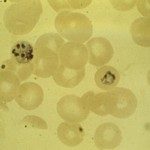Link to Pubmed [PMID] – 2523262
Circ Res 1989 May; 64(5): 937-48
The development of cardiac hypertrophy secondary to pressure overload is accompanied by isoformic changes of contractile proteins such as myosin and actin. 35S-Labeled complementary RNA (cRNA) probes and in situ hybridization procedures were used for analysis of the regional distribution of newly formed transcripts from alpha-skeletal actin (alpha-sk-actin) and beta-myosin heavy chain (beta-MHC) genes during the early stages of pressure overload. The study was performed in 25-day-old rats submitted to a thoracic aortic stenosis and killed after surgery at times ranging from 4 hours to 3 days. Neither alpha-sk-actin nor beta-MHC messenger RNA (mRNA) was detected in the hearts of normal and sham-operated animals. However, alpha-sk-actin mRNA accumulated throughout the entire left ventricle as early as 4 hours after aortic stenosis, and by 12 hours was also detected in the left atrium. In contrast, beta-MHC mRNA was hardly detectable before day 1, and by days 2-3 was mainly restricted to the inner part of the left ventricle and around the coronary arteries. The absence of spatial and temporal coordination in the accumulation of alpha-sk-actin and beta-MHC mRNAs indicates that different signals and/or regulatory mechanisms are implicated in the induction of the two genes in response to hemodynamic overload.

